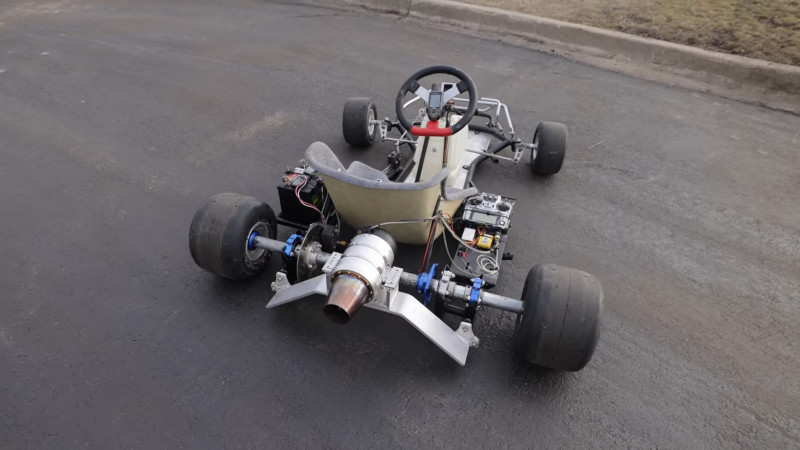Turbine cars never quite came to be, despite many experiments in the 20th century. Despite their high power output for their size, they’re just not well suited to land transport applications; even the M1A1 tank has been much maligned for its turbine power plant. That didn’t stop [Warped Perception] for throwing a jet on the back of a kart though, and it looks like a whole lot of fun. (Video, embedded below.)
The build starts with a garden variety gokart, with the piston engine and all associated running gear stripped off in haste. The RC-sized turbo jet is then mounted on an elegant aluminium bracket, neatly welded on to the back of the car. It’s hooked up with its electronic controller, with throttle controlled by an RC transmitter. It’s not ideal trying to steer one-handed with another on the stick, but these are the sacrifices made when parts don’t arrive in time.
Early testing revealed issues with air ingestion into the fuel line over bumps, but overall performance was impressive. Future plans involve a top speed run which we can’t wait to see. Of course, if it’s not outrageous enough for your taste, consider [Colin Furze’s] pulsejet build.
















Given that the top speed of this is limited by aerodynamic drag rather than engine performance and gearing, I sincerely hope he gives it a good once-over for high-speed operation, particularly tires. Tumbling a go kart at speed doesn’t have a pleasant outcome (experience), and having a flaming turbine in your back pocket will likely make it worse.
https://en.wikipedia.org/wiki/JATO_Rocket_Car
I actually prefer the Johnny Pellegrino version at http://www.the-clearing.org/Jato/rockit.htm
Doubleboost built a jet go cart years ago, including building the jet engine:-
https://www.youtube.com/watch?v=am8P-OleztQ&list=PLwzZw6FLeTRGxhgXf9JOW8_QR2bjfOm4C
For some reason, I am always slightly bummed out to see people ‘building’ jet engines that use off the shelf turbocharger parts. They’re skipping the hard part.
Yep… worked on that kart when Dan Goodwin had it… have built plenty of engines… record set at 116mph
It accelerates like a cow, would be nice to see it as a booster on electric motor.
Maybe he is farmer…
Or at least with an electric motor to get the turbine up to speed faster.
I get the impression that this would work better with a gas turbine rather than a turbojet. A quick online search seems to bring up a few models.
https://www.marineturbine.com/motorcycles/ that’s the best example I can think of!
Another jet-powered go-kart: https://m.youtube.com/watch?v=zsXWspo5hrc/
I read that page – the junkyard he described sounds like dream.
ermmmm…. That was supposed to be a reply…
(I’ve been having a lot of trouble with this on HaD recently…)
Wow! Don’t forget to check out this guys youtube channel. Great stuff
There were a couple of free-piston engine powered go-karts featured in 1960’s magazines. They put out a lot of hot exhaust. When channeled through an appropriately shaped exhaust nozzle and given a shot of water into the exhaust they’d take off like a rocket. One of them also had a small acetylene bottle strapped to the back of the seat for even more boost. I remember one of the articles mentioning the speed had to be limited to 100MPH because the tires were expanding about 1″ in diameter and the back end was trying to lift. The lift could easily have been cured with a couple degrees upward angle on the exhaust. IIRC the article mentioned the builder was looking for small tires capable of handling higher speed.
Another piece of info I recall from one of the articles is the engine was called “loudmouth” due to the high pitch and decble level of its unmuffled exhaust. Fitting it with any kind of muffling device would cut the thrust.
A free piston engine uses two opposed cylinders with two pistons connected onto a solid rod. In theory it should be possible to run a rod through a seal in the center of one head then use a hinged connecting rod to turn a crank to use the engine for a mechanical drive. Problems with that are the super high piston speeds and having a seal able to withstand the heat.
Free piston engines keep the pistons from colliding with the heads by ‘bouncing’ the pistons off the compressed air/fuel mix. With the right design, even if the sparkplug doesn’t ignite it, the compressed air will still prevent collision.
This page has cropped images from a couple of those old magazine covers. https://tinkersource.com/engines/the-free-piston-engine/